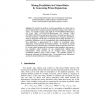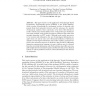PKDD
1999
Springer
13 years 8 months ago
1999
Springer
We describe the problem of mining possibilistic set-valued rules in large relational tables containing categorical attributes taking a finite number of values. An example of such a...
PKDD
1999
Springer
13 years 8 months ago
1999
Springer
A cascade model is a rule induction methodology using levelwise expansion of an itemset lattice, where the explanatory power of a rule set and its constituent rules are quantitativ...
PKDD
1999
Springer
13 years 8 months ago
1999
Springer
Abstract. We describe EDRL-MD, an evolutionary algorithm-based system, for learning decision rules from databases. The main novelty of our approach lies in dealing with continuous ...
PKDD
1999
Springer
13 years 8 months ago
1999
Springer
PKDD
1999
Springer
13 years 8 months ago
1999
Springer
This paper addresses the problem of learning from highly structured data. Speci cally, it describes a procedure, called decomposition, that allows a learner to access automatically...
PKDD
1999
Springer
13 years 8 months ago
1999
Springer
When mining a large database, the number of patterns discovered can easily exceed the capabilities of a human user to identify interesting results. To address this problem, variou...
PKDD
1999
Springer
13 years 8 months ago
1999
Springer
PKDD
1999
Springer
13 years 8 months ago
1999
Springer
This paper reports on the application of the Strongly Typed Evolutionary Programming System
STEPS
to the PTE2 challenge, which consists of predicting the carcinogenic activity of...
PKDD
1999
Springer
13 years 8 months ago
1999
Springer
Abstract. In many applications of data mining a - sometimes considerable - part of the data values is missing. This may occur because the data values were simply never entered into...
PKDD
1999
Springer
13 years 8 months ago
1999
Springer
: For many KDD applications finding the outliers, i.e. the rare events, is more interesting and useful than finding the common cases, e.g. detecting criminal activities in E-commer...





